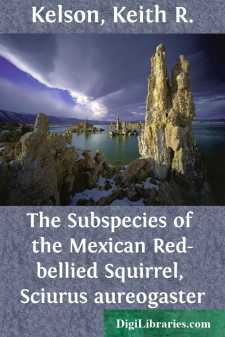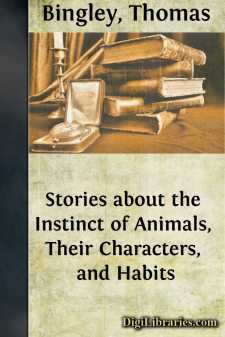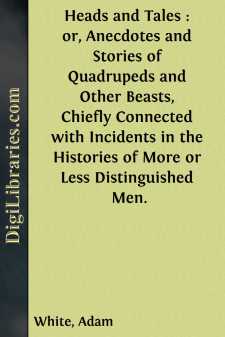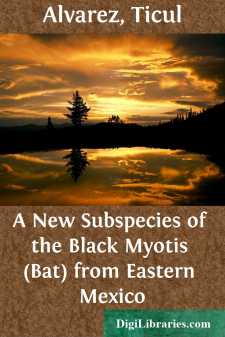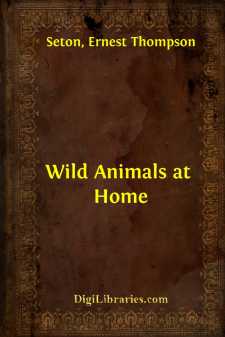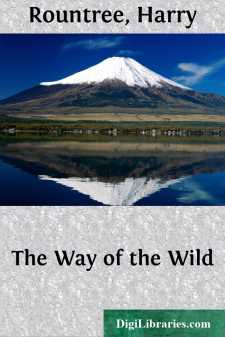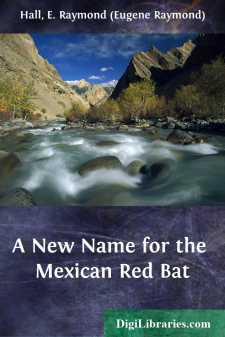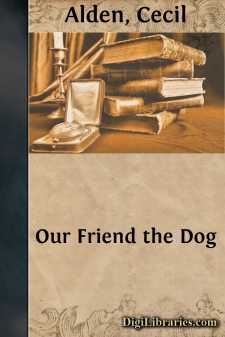Nature
- Animals
- Birds & Birdwatching 41
- Dinosaurs & Prehistoric Creatures 1
- Flowers 5
- General 32
- Horses 6
- Insects & Spiders 19
- Mammals 7
- Mushrooms 2
- Natural Disasters 6
- Natural Resources 3
- Reptiles & Amphibians 2
- Trees & Forests 10
Animals Books
Sort by:
by:
Keith R. Kelson
In his excellent taxonomic treatment of the tree squirrels of Mexico and Central America, Nelson (Proc. Washington Acad. Sci., 1:15-110, 2 pls., May 9, 1899) recognized three subspecies of red-bellied squirrels, Sciurus aureogaster aureogaster F. Cuvier, Sciurus aureogaster hypopyrrhus Wagler, and Sciurus aureogaster frumentor Nelson. In his lists of specimens examined, Nelson (op. cit.:42 and 44)...
more...
by:
Thomas Bingley
CHAPTER IV. Uncle Thomas introduces to the Notice of the Young Folks the Ettrick Shepherd's Stories about Sheep; and tells them some Interesting Stories about the Goat, and its Peculiarities. "I dare say, Boys, you have not forgotten the Ettrick Shepherd's wonderful stories about his dogs. Some of those which he relates about sheep are equally remarkable, and as he tells them in the same...
more...
Last Bull That was what two grim old sachems of the Dacotahs had dubbed him; and though his official title, on the lists of the Zoölogical Park, was “Kaiser,” the new and more significant name had promptly supplanted it. The Park authorities—people of imagination and of sentiment, as must all be who would deal successfully with wild animals—had felt at once that the name aptly embodied the...
more...
by:
Adam White
MAN. In this collection, like Linnæus, we begin with man as undoubtedly an animal, as opposed to a vegetable or mineral. Like Professor Owen, we are inclined to fancy he is well entitled to separate rank from even the Linnæan order, Primates, and to have more systematic honour conferred on him than what Cuvier allowed him. That great French naturalist placed man in a section separate from his...
more...
by:
Ticul Alvarez
In 1928 when Miller and Allen (Bull. U. S. Nat. Mus., 144) published their revisionary account of American bats of the genus Myotis, the black myotis, Myotis nigricans, was known no farther north than Chiapas and Campeche. Collections of mammals made in recent years for the Museum of Natural History of The University of Kansas include specimens of M. nigricans from eastern Mexico as far north as...
more...
I The Cute Coyote AN EXEMPLARY LITTLE BEAST, MY FRIEND THE COYOTE If you draw a line around the region that is, or was, known as the Wild West, you will find that you have exactly outlined the kingdom of the Coyote. He is even yet found in every part of it, but, unlike his big brother the Wolf, he never frequented the region known as Eastern America. This is one of the few wild creatures that you can...
more...
IMPORTANCE OF RODENT GROUPS. As the serious character of the depredations by harmful rodents is recognized, State, Federal, and private expenditures for their control increase year by year. These depredations include not only the attacks by introduced rats and mice on food materials stored in granaries, warehouses, commercial establishments, docks, and private houses, but also, particularly in the...
more...
by:
Harry Rountree
I If his father had been a brown bear and his mother a badger, the result in outward appearance would have been Gulo, or something very much like him. But not all the crossing in the world could have accounted for his character; that came straight from the Devil, his master. Gulo, however, was not a cross. He was himself, Gulo, the wolverine, alias glutton, alias carcajou, alias quick-hatch, alias...
more...
When Gerrit S. Miller, Jr., published his "Revision of the North American Bats of the Family Vespertilionidae" (N. Amer. Fauna, 13:1-140, 3 pls., 39 figs. in text, October 16, 1897), the red bat, Lasiurus borealis, was known from the southern half of Mexico but he did not know that the hoary bat, Lasiurus cinereus, also occurred there. Therefore, the name A[talapha]. mexicana Saussure (Revue et...
more...
by:
Cecil Alden
OUR FRIEND THE DOG I I have lost, within these last few days, a little bull-dog. He had just completed the sixth month of his brief existence. He had no history. His intelligent eyes opened to look out upon the world, to love mankind, then closed again on the cruel secrets of death. The friend who presented me with him had given him, perhaps by antiphrasis, the startling name of Pelléas. Why...
more...


